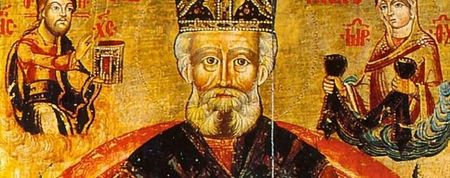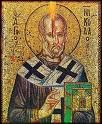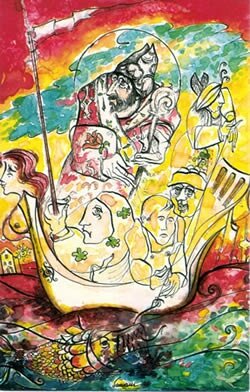 For 16 centuries, tradition has it that Saint Nicholas crosses the globe tonight, leaving presents for all those who have done good deeds throughout the year. Children (young and old, big and small!) polish their boots on the evening of December 5th, so that he will stop by and drop his gifts inside them. Over 811,000 Romanians mark their name day on December 6th.
For 16 centuries, tradition has it that Saint Nicholas crosses the globe tonight, leaving presents for all those who have done good deeds throughout the year. Children (young and old, big and small!) polish their boots on the evening of December 5th, so that he will stop by and drop his gifts inside them. Over 811,000 Romanians mark their name day on December 6th.
Saint Nicholas (Greek: Άγιος Νικόλαος , Agios ["saint"] Nikolaos ["victory of the people"]) (270 - 6 December 346) is the common name for Nicholas of Myra, a saint and Bishop of Myra (Demre, in Lycia, part of modern-day Turkey). Because of the many miracles attributed to him, he is also known as Nicholas the Wonderworker. He had a reputation for secret gift-giving, such as putting coins in the shoes of those who left them out for him, and thus became the model for Santa Claus whose English name comes from the Dutch Sinterklaas. His reputation evolved among the faithful, as is common for early Christian saints. (Wikipedia)
St. Nicolas is surrounded by a rich myriad of tales and legends. One story is that of a poor man who had three daughters. In those days, a young woman's father had to offer prospective husbands a dowry. The larger it was, the better chance she had of finding a good husband and without it, she was unlikely to marry at all. The poor man's daughters had no such dowries and were therefore destined for slavery. Mysteriously, on three different occasions, a bag of gold appeared in their home providing the much-needed riches. The bags, tossed through an open window, are said to have landed in stockings or shoes left in front of the fire to dry, leading to the custom of children hanging up their stockings or putting out shoes. Sometimes the story is told with gold balls instead of bags, hence why three gold balls - today's symbols for pawn brokers, sometimes represented as oranges - are one of the symbols for St. Nicholas.
One of the oldest stories showing St. Nicholas as a protector of children takes place long after his death. The townspeople of Myra were celebrating the good saint on the eve of his feast day when a band of Arab pirates from Crete arrived in the district. They plundered the Church of Saint Nicholas and made off with the booty. As they were leaving town, they snatched a young boy, Basilios, for slavery. The emir selected him as his personal cup-bearer, as Basilios didn't speak Arabic and thus would not understand what the king said to those around him. So, for the next year, Basilios served the king bringing his wine in a beautiful golden cup. For Basilios' parents devastated at the loss of their only child, the year passed slowly and was filled with grief. As the next feast day of St Nicholas approached, Basilios' mother refused to join the festivities for it was now a day of pain although she agreed to keep a simple observance at home - quiet prayers said for Basilios' safekeeping. Meanwhile, many miles away, as Basilios was fulfilling his tasks St. Nicholas suddenly appeared to him, blessed him, whisked him up and set him down again at his home back in Myra still holding the king's golden cup. This is the first story told of St. Nicholas as protector of children which became his primary role in the West.
 Another story tells of three theological students en route to Athens to study. A wicked innkeeper robbed and murdered them, then hid their remains in a large pickling tub. Nice! It so happened that Bishop Nicholas, travelling along the same route, stopped at that very inn. That night, he dreamed of the crime, got up, and summoned the innkeeper. As Nicholas prayed earnestly, the three boys were restored to life. In France, the variation is that of three small children who, wandering in their play, get lost. Lured by an evil butcher, they are captured. St. Nicholas appears and appeals to God to return them to life and to their families.
Another story tells of three theological students en route to Athens to study. A wicked innkeeper robbed and murdered them, then hid their remains in a large pickling tub. Nice! It so happened that Bishop Nicholas, travelling along the same route, stopped at that very inn. That night, he dreamed of the crime, got up, and summoned the innkeeper. As Nicholas prayed earnestly, the three boys were restored to life. In France, the variation is that of three small children who, wandering in their play, get lost. Lured by an evil butcher, they are captured. St. Nicholas appears and appeals to God to return them to life and to their families.
And then there is St. Nicholas and the sea. When he was young, he made a pilgrimage to the Holy Land. There as he walked where Jesus had walked, he sought to experience the Lord's life, passion, and resurrection through meditation. Returning by sea, a mighty storm threatened to wreck the ship. Nicholas calmly prayed. The terrified sailors were amazed when the wind and waves suddenly calmed, sparing them all. No surprise that St. Nicholas is also the patron of sailors and voyagers.
 (Image source: Artist: Michele Damiani; Postcard: Magicatera, Bari, Italy 2007: St Nicholas Center Collection
(Image source: Artist: Michele Damiani; Postcard: Magicatera, Bari, Italy 2007: St Nicholas Center Collection
There are plenty of other stories full of how Nicholas saved his people from famine, spared the lives of those innocently accused and many more. He carried out kind and generous deeds in secret expecting nothing in return. Within a century of his death, he was celebrated as a saint. Today he is venerated in the East as a wonder or miracle worker and in the West as patron of a great variety of people - children, sailors, bankers, pawn-brokers, scholars, orphans, laborers, travellers, merchants, judges, paupers, marriageable maidens, students, children, victims of judicial errors, captives, perfumers, even thieves and murderers. Bref, he is the friend and protector of all in trouble or need.
Sailors claiming St. Nicholas as patron carried stories of his favour and protection far and wide leading to chapels built in many seaports. As his popularity spread throughout the Middle Ages, he became the patron saint of Apulia (Italy), Sicily, Greece, and Lorraine (France), and many cities in Germany, Austria, Switzerland, Italy, Russia, Belgium, and the Netherlands. Following his baptism in Constantinople, Vladimir I of Russia brought St. Nicholas' stories and devotion to his homeland where Nicholas became the most beloved of saints. He was so widely revered that more than 2,000 churches were named for him including three hundred in Belgium, thirty-four in Rome, twenty-three in the Netherlands and more than four hundred in England.
Nicholas' tomb in Myra became a popular place of pilgrimage. Due to the many wars and attacks in the region, some were concerned that access to the tomb might be hampered. For both the religious and commercial advantages of a major pilgrimage site, the Italian cities of Venice and Bari vied for the saint's relics. In the spring of 1087, sailors from Bari managed to spirit away the bones bringing them to Bari, a seaport on the southeast coast. An impressive church was built over St. Nicholas' crypt and many faithful journeyed to honour the saint who had rescued children, prisoners, sailors, famine victims, and many others through his compassion, generosity, and the countless miracles attributed to his intercession. The Nicholas shrine in Bari was one of medieval Europe's great pilgrimage centers and Nicholas became known as "Saint in Bari." To this day, pilgrims and tourists visit Bari's great Basilica di San Nicola.
In Romania and beyond, children typically leave their boots on the window-sill the evening of December 5th. By next morning, Moş Nicolae (Sfântul Nicolae) has left sweets and gifts if they have been good, or a rod (Romanian: nuieluşǎ) if they have not (most children end up getting small gifts but also a small rod).
So, now you know. Happy Feast day to all Nicoles, Nicolettes, Nicoletas, Nicolas's, Nicus, Nikys and Nicks and to all children, both big and small, everywhere!

/https%3A%2F%2Fstorage.canalblog.com%2F03%2F12%2F353913%2F41915630_o.jpg)
/https%3A%2F%2Fstorage.canalblog.com%2F15%2F06%2F353913%2F41915331_o.jpg)
/https%3A%2F%2Fstorage.canalblog.com%2F03%2F68%2F353913%2F41914713_o.jpg)
/https%3A%2F%2Fstorage.canalblog.com%2F22%2F12%2F353913%2F29890995_o.jpg)
/https%3A%2F%2Fstorage.canalblog.com%2F68%2F41%2F353913%2F29890862_o.jpg)


/https%3A%2F%2Fstorage.canalblog.com%2F08%2F12%2F353913%2F116988178_o.jpg)
/https%3A%2F%2Fstorage.canalblog.com%2F59%2F38%2F353913%2F115811794_o.jpg)
/https%3A%2F%2Fstorage.canalblog.com%2F00%2F54%2F353913%2F113969303_o.jpg)
/https%3A%2F%2Fstorage.canalblog.com%2F97%2F57%2F353913%2F112591466_o.jpg)